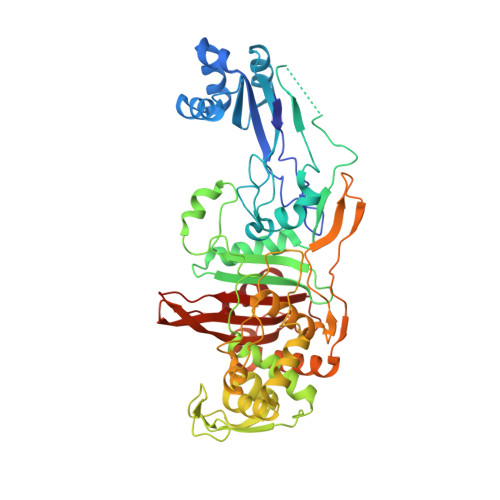A unique class of Zn 2+ -binding serine-based PBPs underlies cephalosporin resistance and sporogenesis in Clostridioides difficile.
Sacco, M.D., Wang, S., Adapa, S.R., Zhang, X., Lewandowski, E.M., Gongora, M.V., Keramisanou, D., Atlas, Z.D., Townsend, J.A., Gatdula, J.R., Morgan, R.T., Hammond, L.R., Marty, M.T., Wang, J., Eswara, P.J., Gelis, I., Jiang, R.H.Y., Sun, X., Chen, Y.(2022) Nat Commun 13: 4370-4370
- PubMed: 35902581
- DOI: https://doi.org/10.1038/s41467-022-32086-6
- Primary Citation of Related Structures:
7RCW, 7RCX, 7RCY, 7RCZ, 7RD0 - PubMed Abstract:
Treatment with β-lactam antibiotics, particularly cephalosporins, is a major risk factor for Clostridioides difficile infection. These broad-spectrum antibiotics irreversibly inhibit penicillin-binding proteins (PBPs), which are serine-based enzymes that assemble the bacterial cell wall. However, C. difficile has four different PBPs (PBP1-3 and SpoVD) with various roles in growth and spore formation, and their specific links to β-lactam resistance in this pathogen are underexplored. Here, we show that PBP2 (known to be essential for vegetative growth) is the primary bactericidal target for β-lactams in C. difficile. PBP2 is insensitive to cephalosporin inhibition, and this appears to be the main basis for cephalosporin resistance in this organism. We determine crystal structures of C. difficile PBP2, alone and in complex with β-lactams, revealing unique features including ligand-induced conformational changes and an active site Zn 2+ -binding motif that influences β-lactam binding and protein stability. The Zn 2+ -binding motif is also present in C. difficile PBP3 and SpoVD (which are known to be essential for sporulation), as well as in other bacterial taxa including species living in extreme environments and the human gut. We speculate that this thiol-containing motif and its cognate Zn 2+ might function as a redox sensor to regulate cell wall synthesis for survival in adverse or anaerobic environments.
Organizational Affiliation:
Department of Molecular Medicine, Morsani College of Medicine, University of South Florida, Tampa, FL, 33612, USA.
















